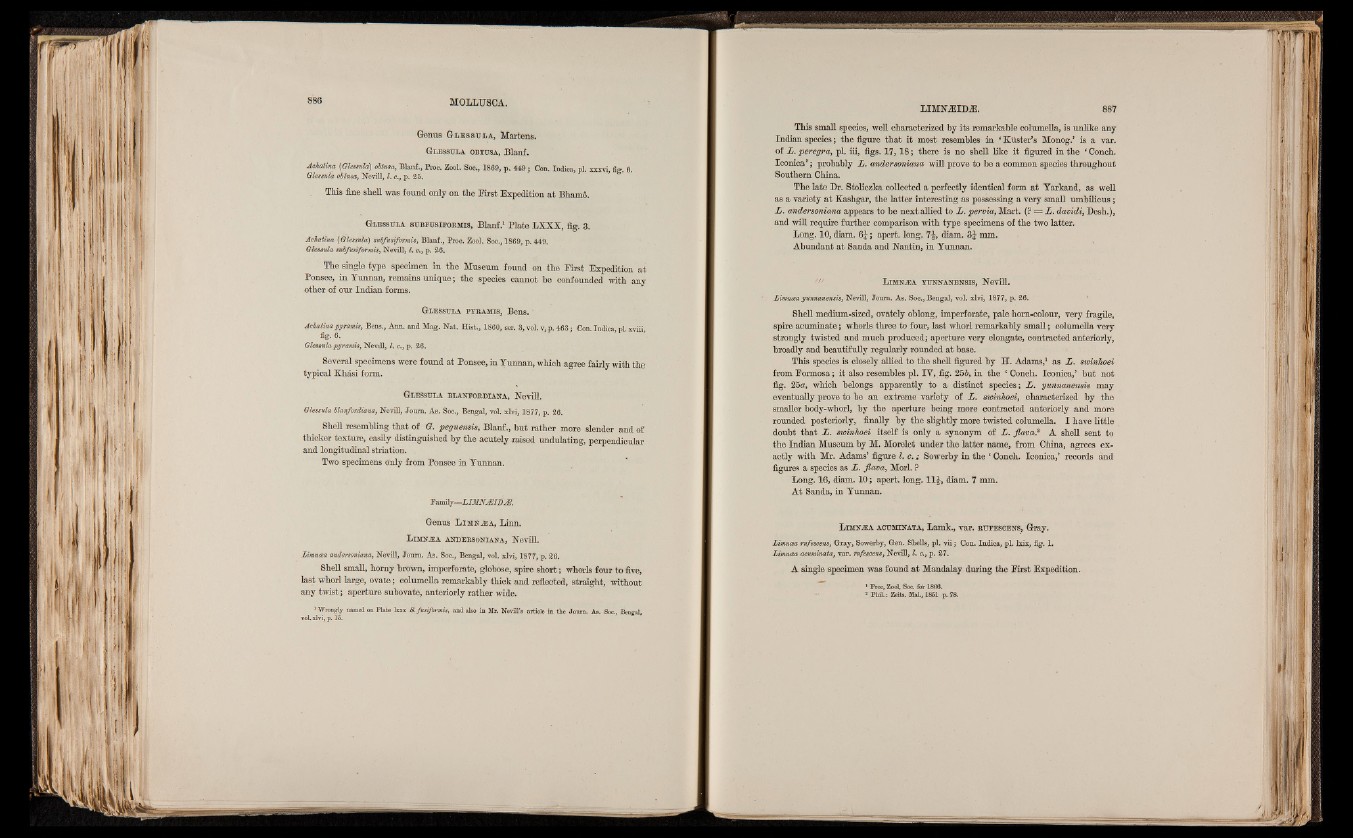
Genus G l e s s u l a , Martens.
G l e s s u l a o b t u s a , Blanf.
Aehatina {Glessula) obtusa, Blanf., Proc. Zool. Soc., 1869, p. 449; Con. Indiea, pi. xxxvi, fig. 6.
Glessula obtusa, Nevill, I. c., p. 25.
This fine shell was found only on the Eirst Expedition at Bhamfi.
G l e s s u l a s u b f u s I f o r m i s , Blanf.1 Plate LXXX, fig. 3.
Aehatina {Glessula) svhfusifbrmis, Blanf., Proc. Zool. Soc., 1869, p. 449.
Glessula subfusiformis, Nevill, I. c., p. 26.
The single type specimen in the Museum found on the First Expedition at
Ponsee, in Yunnan, remains unique; the species cannot he confounded with anv
•other of our Indian forms.
G l e s s t jl a p y r a m i s , Bens.
Aehatina pyramis, Bens., Ann. and Mag. Nat. Hist., 1860, ser. 3, vol. v,p. 468: Con. Indica pi xviii
fig. 6. |
Glessula pyramis, Nevill, I. c., p. 26.
Several specimens were found at Ponsee, in Yunnan, which agree fairly with the
typical Khasi form.
G l e s s u l a b l a n f o r d ia n a , Nevill.
Glessula blanfordiana, Nevill, Joum. As. Soc., Bengal, vol. xlvi, 1877, p. 26.
Shell resembling that of G. peguensis, Blanf., but rather more slender and of
thicker texture, easily distinguished by the acutely raised undulating, perpendicular
and longitudinal striation.
Two specimens only from Ponsee in Yunnan.
Family—L IM NM IfiM .
Genus Limn A! A, Linn.
LlMNiEA ANDERSONIANA, Nevill.
Limncea andersoniana, Nevill, Joum. As. S'oC., Bengal, vol. xlvi, 1877, p. 26.
Shell small, homy brown, imperforate, globose, spire short; whorls four to five,
last whorl large, ovate; columella remarkably thick and reflected, straight, without
any twist; aperture subovate, anteriorly rather wide.
1 Wrongly named on Plate k n 8. fusiformis, and also in Mr. NevilTs article in the Jotum. As. Soc., Bengal,
vol. xlvi, p. 15.
This small species, well characterized by its remarkable columella, is unlike any
Indian species; the figure that it most resembles in ‘ Kuster’s Monog.’ is a var.
of L. peregra, pi. iii, figs. 17,18; there is no shell like it figured in the * Conch.
Iconica’ ; probably L. andersoniana will prove to be a common species throughout
Southern China.
The late Dr. Stoliczka collected a perfectly identical form at Yarkand, as well
as a variety at Kashgar, the latter interesting as possessing a very small umbilicus;
L . andersoniana appears to be next allied to L. pervia. Mart. (? = L. da/oidi, Desh.),
and will require further comparison with type specimens of the two latter.
Long. 10, diam. 6|-; apert. long. *l\, diam. 3^ mm.
Abundant at Sanda and Nantin, in Yunnan.
/ / y L im n ^ a y t j n n a n e n s i s , Nevill.
Limncea ywwwa?ie«iw, Nevill, Joum. As. Soc., Bengal, vol. xlvi, 1877, p. 26.
Shell medium-sized, ovately oblong, imperforate, pale horn-colour, very fragile,
spire acuminate; whorls three to four, last whorl remarkably small; columella very
strongly twisted and much produced; aperture very elongate, contracted anteriorly,
broadly and beautifully regularly rounded at base.
This species is closely allied to the shell figured by H. Adams,1 as I . stoinhoei
from Formosa; it also resembles pi. IY, fig. 255, in the ‘Conch. Iconica,’ but not
fig. 25a, which belongs apparently to a distinct species; L. yunnanensis may
eventually prove to be an extreme variety of L. stoinhoei, characterized by the
smaller body-whorl, by the aperture being more contracted anteriorly and more
rounded posteriorly, finally by the slightly more twisted columella. I have little
doubt that L. stoinhoei itself is only a synonym of L. flrna? A shell sent to
the Indian Museum by M. Morelet under the latter name, from China, agrees exactly
with Mr. Adams’ figure I. e ,; Sowerby in the ‘ Conch. Iconica,’ records and
figures a species as L. flava, Mori. ?
Long. 16, diam. 10; apert. long. 11£, diam. 7 mm.
At Sanda, in Yunnan.
L im n -e a a c u m in a t a , Lamk., var. r u f e s c e n s , Gray.
Lim/ncea rufescens, Gray, Sowerby, Gen. Shells, pi. vii j Con. Indica, pi. lxix, fig. 1.
Limncea acuminata, var. rufescens, Nevill, I. c., p. 27.
A single specimen was found at Mandalay during the Eirst Expedition.